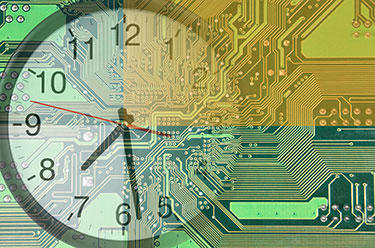
Our fast-approaching future of driverless cars and "smart" electrical grids will depend on billions of linked devices making decisions and communicating with split-second precision to prevent highway collisions and power outages. But a new report released by the National Institute of Standards and Technology (NIST) warns that this future could be stalled by our lack of effective methods to marry computers and networks with timing systems.
The authors, who include NIST's Marc Weiss and seven experts from academia and industry, are concerned about the way most modern data systems are designed to process and exchange data with one another and what that could mean for a world of discrete processors and mechanical devices linked by an information network—the "Internet of Things" (IoT). In addition to giving you access to the status of your home appliances anywhere, anytime, the IoT encompasses many potentially important but delicate applications such as cars that drive themselves and telemedicine surgical suites that allow doctors to operate on patients from remote locations. People are still imagining applications for the IoT, but GE predicts that nearly half the global economy can benefit from it.
The trouble is that these applications frequently will depend on precision timing in computers and networks, which were designed to operate optimally without it. For example, for a driverless car to decide whether what it senses ahead is a plastic bag blowing in the wind or a child running, its decision-making program needs to execute within a tight deadline. Yet modern computer programs only have probabilities on execution times, rather than the strong certainties that safety-critical systems require.
In addition, many IoT systems will require precision synchronization across networks. "Imagine writing a letter to your friend saying it is now 2:30 p.m., and then sending it by snail mail so he can synchronize his watch with yours," says Weiss. "That's the equivalent of how accurate the timing of messages are in computers and systems right now. The transfer delay must be accounted for to do the things that are expected of the IoT."
In their paper, the authors review the state of the art in several areas central to the use of timing signals and find that crosscutting research is needed to improve current technology and approach. These areas include clock design, the use of timing in networking systems, hardware and software architecture, and application design, among others.
Weiss outlines research areas that could address these issues. Networked components need a way to combine time-sensitive processes and those that can be done whenever the system gets around to them, he says. Additionally, systems need to be designed from the ground up to accommodate updates to computer applications and networks where timing is critical, updates that are virtually inevitable as systems change and grow. Currently, systems need to be rebuilt and recalibrated every time they become obsolete, costing time and money.
"The kind of growth in the IoT that is expected to happen will be severely hampered without these improvements," he says. "It won't be able to grow the way people want."
M. Weiss, J. Eidson, C. Barry, D. Broman, L. Goldin, B. Iannucci, E.A. Lee and K. Stanton. Time-Aware Applications, Computers, and Communication Systems (TAACCS). NIST Tech Note 1867, Feb. 21, 2015. http://dx.doi.org/10.6028/NIST.TN.1867

